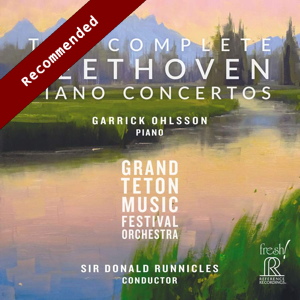
Ludwig van Beethoven (1770-1827)
Piano Concerto No 1 in C major, Op 15
Piano Concerto No 2 in B-flat major, Op 19
Piano Concerto No 3 in C minor, Op 37
Piano Concerto No 4 in G major, Op 58
Piano Concerto No 5 in E-flat major ‘Emperor‘, Op 73
Overture – The Creatures of Prometheus, Op. 43
Garrick Ohlsson (piano)
Grand Teton Music Festival Orchestra/Sir Donald Runnicles
rec. 2022, Walk Festival Hall, Teton Village, USA
Reference Recordings FR-751 SACD [3 discs: 186]
It was in 1970 that American classical pianist Garrick Ohlsson clinched first prize in the International Chopin Piano Competition in Warsaw. He later went on to win the Busoni Competition and the Montreal Piano Competition. In addition, he’s been nominated for three Grammy Awards, winning one in 2008. Throughout his illustrious career he’s been closely associated with the music of Frédéric Chopin yet, as a pupil of the late Claudio Arrau, his repertoire has also gravitated towards the works of Mozart, Beethoven and Schubert. He’s now 75 and was asked to record Beethoven’s five piano concertos at the Grand Teton Music Festival in Jackson Hole, Wyoming in partnership with its Music Director Sir Donald Runnicles. The recordings were captured live, according to the booklet notes, over two evenings. Audience presence is barely noticeable, and applause has been removed.
I began the journey by listening to the Piano Concerto No. 2 in B flat major, Op. 19, which is the composer’s earliest concerto but the second to be published. It’s more lightly scored than the First. Runnicles sets an agreeable tempo in the tutti, with Ohlsson delivering a spirited and joyous account of the opening movement. The central slow movement offers a more probing and inwardly focused account than some I’ve heard. The upbeat finale is witty and punchy, and brims over with copious energy. In the First Concerto the outer movements are ebullient and crisp. Ohlssohn employs Beethoven’s long cadenza in the first movement. There’s much poetry and refinement in the slow movement, and I love the way Ohlssohn expressively shapes the phrases, with subtle grace and sensitivity.
Mozart permeates the score of the Third Concerto. The influence is Mozart’s Piano Concerto No. 24, K. 491, in the same key of C minor. The first movement is epic in scale, dramatic, muscular and darkly etched. Ohlsson and Runnicles capture the sombre mood of foreboding effectively. The Largo which follows is in the remote key of E major. It’s both tender and romantic; the pianist precisely weighs every chord. The Rondo has sufficient bite and rhythmic tautness to successfully round off the work.
With five bars of solo piano, Beethoven draws the listener into the intimate world of his Fourth Concerto. Ohlsson’s opening is magical in its effect, and it casts a powerful spell. After a well-paced tutti, a sublime dialogue it brought into play between solo piano and orchestra. The piano sounds quite improvisatory. In the slow movement, the composer sets orchestral declamations against a conciliatory piano line. This leads without a break into an extrovert finale. Throughout, Runnicles is a fine, supportive partner, providing alert orchestral response.
The Fifth Concerto is a magisterial account in the hands of Ohlsson and Runnicles. The pianist is well-matched to the virtuosity and bravura of the work, giving it sufficient weight and texture. I also admire his attention to the finer details. I particularly enjoyed the central Adagio for its serenity and hymn-like quality. The finale carries one along with a surfeit of rhythmic energy. As much as I like the performance it won’t replace my favorite version of the work with Pollini on DG conducted by Karl Böhm.
I have several Reference Recordings in my collection and I’m always bowled over by their impeccability, where everything is recorded and mastered to perfection. For me, they’re the crème de la crème when it comes to recorded sound. This new release is no exception. The engineers have done a sterling job in placing the solo piano ideally in the sound picture. The three discs (Hybrid SACDS with Stereo SACD, 5.0 Surround SACD and Stereo CD layers) come nicely presented in the traditional fatbox format, and are well-annotated. There’s no doubting that this will be one of my Recordings of the Year.
Stephen Greenbank
Help us financially by purchasing from





















